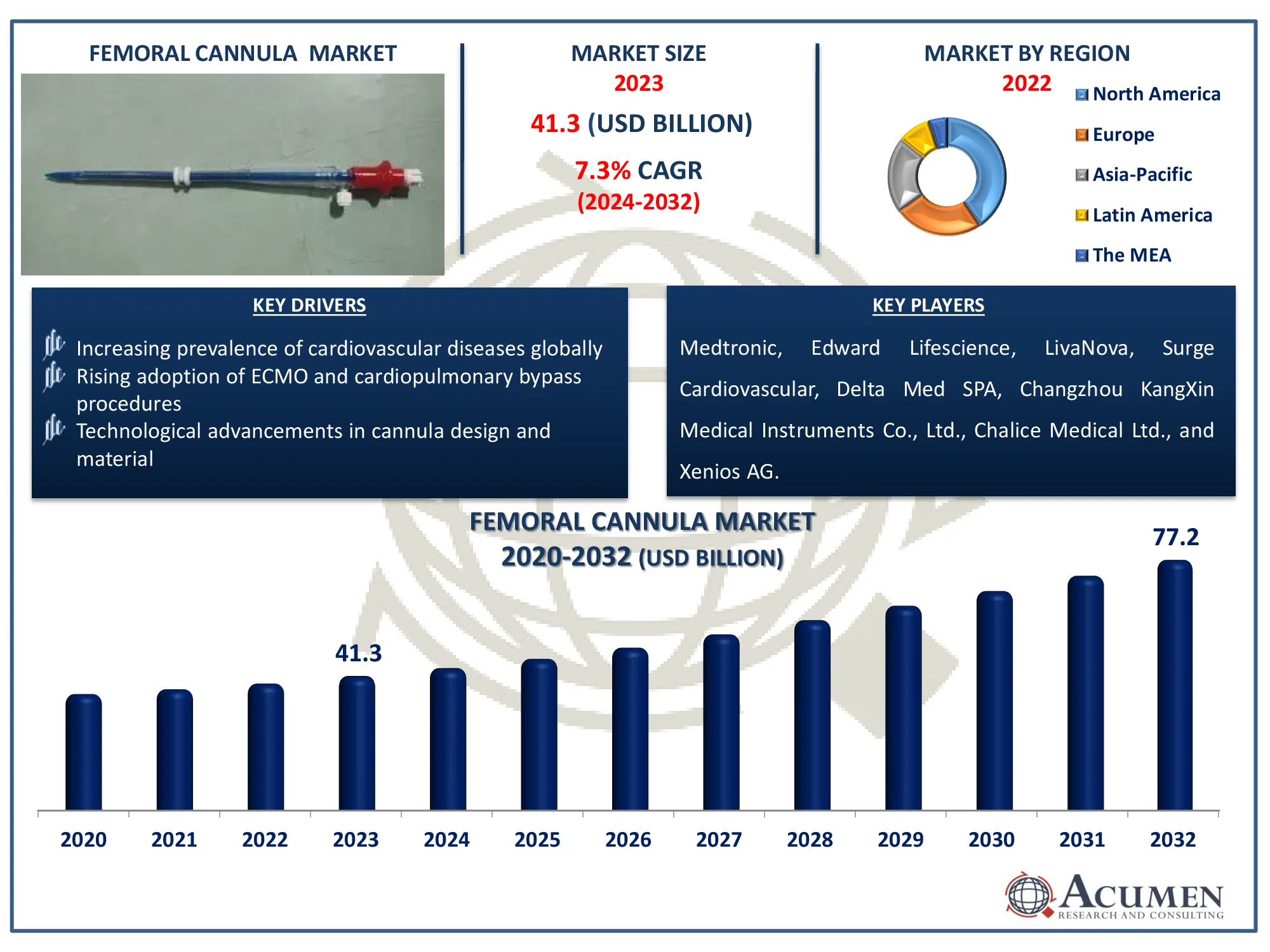Femoral Cannula Market Size - Global Industry, Share, Analysis, Trends and Forecast 2024 - 2032
Published :
Report ID:
Pages :
Format :
Femoral Cannula Market Size - Global Industry, Share, Analysis, Trends and Forecast 2024 - 2032
Report Coverage
- Industry Dynamics
- Market Size and Forecast Data
- Segment Analysis
- Competitive Landscape
- Regional Analysis with a Niche Focus on Country-Level Data
- High Level Analysis - Porter's, PESTEL, Value Chain, etc.
- Company Profiles of Key Players
- Option to Customize the Report As Per Your Specific Need
Request Sample Report
The Global Femoral Cannula Market Size accounted for USD 41.3 Billion in 2023 and is estimated to achieve a market size of USD 77.2 Billion by 2032 growing at a CAGR of 7.3% from 2024 to 2032.
Femoral Cannula Market (By Product: Femoral Arterial Cannula, Femoral Venous Cannula; By Application: Cardiac Surgical Interventions, Hemodialysis Access, Cardiopulmonary Resuscitation, Hemoperfusion Access, Extracorporeal Membrane Oxygenation (ECMO) support, Extracorporeal life Support, Others; By Output: Hospitals, Clinics, Dialysis Centers, Cardiac Surgical Centers, and Ambulatory Surgery Centers and By Region: North America, Europe, Asia-Pacific, Latin America, and MEA)
Femoral Cannula Market Highlights
- The global femoral cannula market is anticipated to reach USD 77.2 billion by 2032, growing at a CAGR of 7.3% from 2024 to 2032
- In 2023, the North American femoral cannula market was valued at approximately USD 16.5 billion
- The Asia-Pacific region is projected to grow at a CAGR of over 8% from 2024 to 2032
- In 2023, the femoral arterial cannula product represented 59% of the market share
- The cardiac surgical interventions sub-segment accounted for 41% of the market share in 2023
- Hospitals made up 45% of the market share in 2023
- More healthcare facilities are using femoral cannulas for quick access during emergency and critical care situations is the femoral cannula market trend that fuels the industry demand

A femoral cannula is a medical device that allows access to the femoral artery or vein, usually for operations such as extracorporeal membrane oxygenation (ECMO) or cardiopulmonary bypass. It permits blood to circulate outside the body during surgeries or critical care procedures. It improves oxygenation and removes carbon dioxide from the blood in ECMO. It is often used in vascular procedures to temporarily divert blood flow. Femoral cannulation is the favored procedure due to its ease of access, especially in emergency or intensive care conditions.
Global Femoral Cannula Market Dynamics
Market Drivers
- Increasing prevalence of cardiovascular diseases globally
- Rising adoption of ECMO and cardiopulmonary bypass procedures
- Technological advancements in cannula design and material
Market Restraints
- High costs associated with advanced femoral cannulae
- Risk of complications such as infections and vascular injury
- Lack of skilled professionals for complex procedures in some regions
Market Opportunities
- Growing demand for minimally invasive surgeries
- Expanding healthcare infrastructure in emerging markets
- Development of bio-compatible materials and improved safety features
Femoral Cannula Market Report Coverage
| Market | Femoral Cannula Market |
| Femoral Cannula Market Size 2022 |
USD 41.3 Billion |
| Femoral Cannula Market Forecast 2032 | USD 77.2 Billion |
| Femoral Cannula Market CAGR During 2023 - 2032 | 7.3% |
| Femoral Cannula Market Analysis Period | 2020 - 2032 |
| Femoral Cannula Market Base Year |
2022 |
| Femoral Cannula Market Forecast Data | 2023 - 2032 |
| Segments Covered | By Product, By Application, By End-Use, And By Geography |
| Regional Scope | North America, Europe, Asia Pacific, Latin America, and Middle East & Africa |
| Key Companies Profiled | Medtronic, Edward Lifescience, LivaNova, Surge Cardiovascular, Delta Med SPA, Changzhou KangXin Medical Instruments Co., Ltd., Chalice Medical Ltd., and Xenios AG. |
| Report Coverage |
Market Trends, Drivers, Restraints, Competitive Analysis, Player Profiling, Covid-19 Analysis, Regulation Analysis |
Femoral Cannula Market Insights
The rising prevalence of cardiovascular illnesses, such as heart failure and coronary artery disease, increases demand for femoral cannula, which play a crucial role in life-saving procedures like ECMO and cardiopulmonary bypass. For instance, According American Heart Association, more than 184 million people, or 61% of the U.S. population, are likely to have some type of cardiovascular disease (CVD), and total CVD-related costs are expected to triple to $1.8 trillion by 2050, according to projections reported in two new American Heart Association presidential advisories. Due to these illnesses frequently require surgical intervention or mechanical circulatory support, femoral cannula have become essential for healthy blood management during these complex treatments. With the global rise in cardiovascular disease, there is growing need directly benefits the femoral cannula industry.
The potential of consequences, such as infections and vascular damage, suppress the expansion of the femoral cannula market by raising patient safety concerns. For instance, according to National Library of Medicine, the longest stay for patient was 43 days, when a patient had their forearm amputated and developed an infection that required extra surgery to treat. These issues might have serious consequences, such as longer hospital stays, extra treatments, and higher healthcare expenditures. As a result, safety concerns impede market growth, particularly in regions with strict healthcare laws.
The increased demand for minimally invasive operations creates a huge opportunity for the femoral cannula market because these procedures require efficient vascular access with minimal stress. Technological advancements in minimally invasive devices by key manufacturers to provide proper treatment for patients further enhance market demand for femoral cannual. For instance, in June 2021, Intuitive India, the India arm of Intuitive, a global technological leader in minimally invasive treatment and the pioneer of robotic-assisted surgery (RAS), will launch India's first robotic-assisted surgical stapler, SureForm. Overall, as patients and healthcare providers desire operations with faster recovery times and fewer complications, the use of femoral cannulae in these surgeries is increasing.
Femoral Cannula Market Segmentation
The worldwide market for femoral cannula is split based on product, application, end-use, and geography.
Femoral Cannula Product
- Femoral Arterial Cannula
- Femoral Venous Cannula
According to the femoral cannula industry analysis, the femoral arterial cannula leads the market due to its importance in high-demand operations such as extracorporeal membrane oxygenation (ECMO) and cardiopulmonary bypass. For instance, according to Journal of Thoracic Disease, the key advantages of the femoral artery are that it is easily accessible and does not require graft anastomosis, allowing for quick cannulation. Another advantage is that it allows for the initiation of cardiopulmonary bypass before to the sternotomy, as well as cooling the patient in case of circulatory arrest. Its ability to accelerate blood flow from the artery to external devices is critical in life-saving treatments for heart and lung failure. This dominance is maintained by continual improvements in arterial cannulation technology.
Femoral Cannula Application
- Cardiac Surgical Interventions
- Hemodialysis Access
- Cardiopulmonary Resuscitation
- Hemoperfusion Access
- Extracorporeal Membrane Oxygenation (ECMO) support
- Extracorporeal life Support
- Others
The cardiac surgical interventions category leads the femoral cannula market because femoral cannulae are required for operations such as cardiopulmonary bypass and extracorporeal membrane oxygenation (ECMO), which are frequently employed in heart surgeries. With an increasing frequency of heart illness and a growing number of cardiac procedures, demand for femoral cannulae in this category remains high. For instance, according to World Heart Federation, Cardiovascular illnesses continue to impact over 500 million people worldwide, causing 20.5 million deaths in 2021. This results in a segment's domination in the industry.
Femoral Cannula End-Use
- Hospitals
- Clinics
- Dialysis Centers
- Cardiac Surgical Centers
- Ambulatory Surgery Centers
According to the femoral cannula market forecast, hospitals dominates due to their vital involvement in complex treatments such as extracorporeal membrane oxygenation (ECMO) and cardiac surgery. These hospitals have the requisite infrastructure, competent staff, and advanced technologies to perform such procedures, making them the leading users of femoral cannulae. Furthermore, the the ability of hospitals to handle enormous patient loads contributes to their market dominance.
Femoral Cannula Market Regional Outlook
North America
- U.S.
- Canada
Europe
- U.K.
- Germany
- France
- Spain
- Rest of Europe
Asia-Pacific
- India
- Japan
- China
- Australia
- South Korea
- Rest of Asia-Pacific
Latin America
- Brazil
- Mexico
- Rest of Latin America
The Middle East & Africa
- South Africa
- GCC Countries
- Rest of the Middle East & Africa (ME&A)

Femoral Cannula Market Regional Analysis
For several reasons, North America dominates the femoral cannula market due to its high prevalence of cardiovascular illnesses and excellent healthcare infrastructure. For instance, according to Centers for Medicare & Medicaid Services (CMS), U.S. health-care spending increased by 4.1% to $4.5 trillion in 2022, faster than the 3.2% growth in 2021. The region offers a well-established network of hospitals and specialty surgical centers that perform operations such as ECMO and cardiac surgery. Furthermore, significant investment in medical technology and research and development contributes to the market's dominance.
Asia-Pacific anticipated to growing rapidly in the femoral cannula market, owing to developing healthcare infrastructure. Government efforts to improve healthcare accessible, as well as expenditures in modern medical technology, help to drive market expansion. For instance, according to India Brand Equity Foundation, the Indian government intends to launch a credit incentive programme costing Rs. 50,000 crore (US$ 6.8 billion) to improve the country's healthcare infrastructure. Rising prevalence of cardiovascular illnesses further boosts regional growth in forecast year.
Femoral Cannula Market Players
Some of the top femoral cannula companies offered in our report include Medtronic, Edward Lifescience, LivaNova, Surge Cardiovascular, Delta Med SPA, Changzhou KangXin Medical Instruments Co., Ltd., Chalice Medical Ltd., and Xenios AG.
Frequently Asked Questions
How big is the femoral cannula market?
The femoral cannula market size was valued at USD 41.3 billion in 2023.
What is the CAGR of the global femoral cannula market from 2024 to 2032?
The CAGR of femoral cannula is 7.3% during the analysis period of 2024 to 2032.
Which are the key players in the femoral cannula market?
The key players operating in the global market are including Medtronic, Edward Lifescience, LivaNova, Surge Cardiovascular, Delta Med SPA, Changzhou KangXin Medical Instruments Co., Ltd., Chalice Medical Ltd., and Xenios AG.
Which region dominated the global femoral cannula market share?
North America held the dominating position in femoral cannula industry during the analysis period of 2024 to 2032.
Which region registered fastest CAGR from 2024 to 2032?
Asia-Pacific region exhibited fastest growing CAGR for market of femoral cannula during the analysis period of 2024 to 2032.
What are the current trends and dynamics in the global femoral cannula industry?
The current trends and dynamics in the femoral cannula industry include increasing prevalence of cardiovascular diseases globally, rising adoption of ECMO and cardiopulmonary bypass procedures, and technological advancements in cannula design and material.
Which product held the maximum share in 2023?
The femoral arterial cannula product held the maximum share of the femoral cannula industry.



